Popular Science Takes Drugs
From our archive: a reporter's LSD trip, a guide to getting high during Prohibition, and more
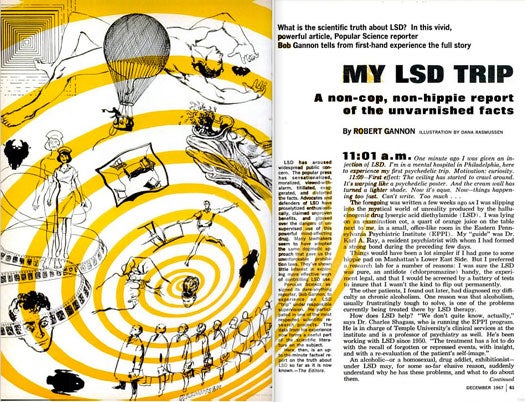
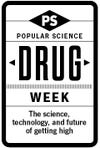
Drug Week
This article originally appeared on PopSci.com on January 7, 2011.
Working and writing for Popular Science means being able to do fun things, like playing with the latest consumer electronics in Las Vegas, touring the Shanghai Expo, and getting paid to do hard drugs. We’re not kidding. In 1967, reporter Robert Gannon spent a weekend getting high on LSD at a psychiatric institution in Pennsylvania. Under close supervision, Gannon passed the next 24 hours doing pirouettes, rolling around in the grass, biting his arms, and mumbling about the depravity of his generation. Then he got to write about it.
“I’m totally insane,” he said. “I know because I can see reality as it flicks past, just a little slit of sunlight. I’m in a giant maelstrom, swirling, whirling, with reality only a small slot in the side.”
Although it was written to simply describe an LSD experience, the vividness of Gannon’s article inadvertently reinforces the allure of illicit substances. You can’t read something like the sentence above without understanding how drugs have become such an integral part of contemporary society. Drug addiction is nothing new, but as our archives will attest, the organized drug trade is constantly using sneakier ways to smuggle increasingly sophisticated products.
At the turn of the century, cocaine, heroin, and opium ruled the drug scene. Smugglers sewed dope into their jacket hems and injected heroin into oranges, which were then sold to prisoners who were already serving time for selling drugs.
The drug problem only got worse once Prohibition came into effect. We explored how the methods people used to snort up drugs and the possible physical effects, including “saddle nose”—or what is today known as “coke nose.”
As the decades wore on, researchers worked to develop a non-toxic medication to wean addicts off drugs. The University of Virginia labored to create a “dopeless dope,”while scientists attempted to breed hemp that didn’t contain the marijuana component.
It’s been a good 60 years, and scientists are still working to perfect the technology. Those experiments might not have ended well, but plenty of other anti-drug measures did. Click through our gallery to read about how we covered the rise of marijuana in the 1960’s, the corruption among dope-addicted diplomats, and how one agent who dubbed himself “Flash” busted drug rings on the regular.

In 1918, the Secretary of Treasury appointed a special committee to study nationwide drug trafficking. They reported dope-smuggling cost the United States $61 million per year, while an increased number of minors were struggling with addiction. Although everyone from housewives, to actresses, to businessmen, to farmers were susceptible to the problem, we reported that prisoners used particularly clever means to procure a steady supply of drugs. Visitors could slip them a “dope sandwich,” or two dollar bills with a thin film of cocaine hidden between them. If you couldn’t afford to give away two dollars, you could also sneak some powder between torn corners of a postcard. Even more smugglers sewed cocaine into the hemlines of their coats, injected fruit with heroin, or baked opiates into bars of soap. Apparently, not much has changed in the last 100 years.

America’s dope problem only worsened during the following decade. In 1930, we reported that one out of every six people struggled with an addiction to narcotics. To understand how the number of illegal drug users quadrupled in just ten years, we interviewed Dr. William I. Sirovich, a narcotics expert from New York. Dr. Sirovich explained that the Prohibition, which began in 1920, only encouraged people with addictive tendencies to substitute alcohol for hard drugs. In terms of restoring morality to America, the Prohibition totally backfired. Secondly, peddling drugs is a lot easier than smuggling alcohol. Like we reported just a decade earlier, people could sneak coke around in their pockets. Moreover, even though drug addiction affected people from all walks of life, society associated drug use with common criminals and the homeless. Because of the taboo, regular folks were ashamed to seek help for their problems. Sirovich recommended that since most narcotics factories were overseas, that President Hoover call an international convention to “engage in a world-wide anti-drug crusade,” perhaps even to start a “narcotics League of Nations.” Pictured left is an illustration of Dr. Sirovich, who was also a Congressman, asking representatives to start a bureau dedicated to quashing the narcotics trade.
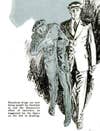
In an effort to wean druggies off their addiction, chemists at the University of Virginia labored to develop a non habit-forming drug that simulated the effects of opium, morphine, heroin and cocaine without harming the bodies of those using it. We called the theoretical synthetic drug “dopeless dope,” or the narcotics equivalent of a nicotine patch. Researchers tried to methods of producing safe narcotics: firstly, by purifying opium to isolate its harmful elements, and secondly, by studying the molecules within narcotics to figure out what made them so addictive. To create a non-addictive narcotic, scientists reasoned that they’d have to find a harmless chemical that would not cause permanent damage to cells.

Up until the mid-1930’s, we considered opium the premiere addictive drug. Marijuana was merely a “Mexican Border problem” and a substance belonging within “the limbo of forgotten drugs.” Authorities only realized they were dealing with a nationwide problem when fields began cropping up in Pennsylvania, New York, California and Ohio. They even found small backyard plots in San Francisco and New Jersey. Unlike dope, cannabis was easy to grow, procure and prepare. At the time, prosecuting marijuana peddlers was a tricky business since many states outlawed only the importation of the weed. Smoking it and growing was no problem.
“An innocent-looking plant, a roadside weed in many states, presents a grave narcotic problem,” we said. As a reputable magazine, there was only one sanctioned thing we could do to alleviate the problem: give our readers a guide on how to recognize marijuana so they could shut down their neighbors.

Harold “Flash” Murray, a former U.S. anti-narcotic agent, despised organized drug rings. “You are dealing with human rats, cunning and ruthless,” he said. “The pay is never big. But there is tremendous satisfaction in outwitting these enemies of society.”
In a first-person account reminiscent of pulp novels and crime noir, Murray retold his adventures fighting “torpedoes,” or gun men employed by dope rings, and how he became an expert in the “wiles of the underworld.” For instance, tenement building residents developed a maneuver called “hanging out the wash,” where a gang uses clotheslines to transport drugs from apartment to apartment. Gang members would hang socks just outside their windows so that in the event of a raid, they could drop their supply into the socks and have the neighboring gang pull them away from sight. To catch gangs, Murray would employ tricks like wandering near drug dens on crutches, since most drug rings wouldn’t suspect much from a crippled person. Once at the door, he would throw down his disguise, signal his partners, and “hit the gang’s hideout like terriers in a rat’s nest.”

World War II presented the Department of Agriculture with a tough dilemma. The military desperately needed twine and rope. Previously, the country imported fiber from the Philippines and Dutch East India, but since the war cut off those supplies, they needed to use hemp fiber, which could easily grow on American farmland. Inconveniently enough, those hemp farms would likely exacerbate the drug trade by yielding generous amounts of marijuana.
Experts suggested breeding a strain of hemp containing only trace amounts of psychoactive properties. Since testing the product on humans would be problematic, Dr. H.E. Warme, from New York State, administered his experimental substances on fish. To develop “drugless hemp,” he first had to determine the exact marijuana content of hemp. After extracting and converting it to powder, he’d create four different solutions of the drug ranging from very strong to weak. Placing a pair of killifish in beakers containing the solutions gave him a general measurement of the drug’s potency. Dr. Warme would repeat his experiments on various hemp cross-breeds in hope of achieving a generation non-toxic hemp.
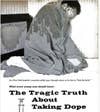
It’s easy to demonize drug addicts. We ask why they don’t just kick they habit, why they can’t just refrain from buying the stuff, and why they can’t retain some self-control. Although there are plenty of psychological reasons why someone would remain in such a destructive lifestyle, we offered a scientific primer on addiction, withdrawal, and the experience of getting high. We wrote: “When he can’t get ‘fixed,’ the drug addict is in for days of utter misery, twitching, vomiting, diarrhea–and terror.”
While drug addicts are stereotyped as strung-out celebrities or gang members, we emphasized that the typical narcotic user was a regular person. According to psychiatrists, they’re just “intelligent people cursed with inadequate personalities, who find many of life’s problems exceedingly painful.”

The underground narcotics scene flourished throughout the 1960’s, thanks to the assistance smugglers received from corrupt diplomats. At least that’s what Harry L. Giordano, Commissioner of the U.S. Bureau of Narcotics, insisted. With Giordano’s help, we published an expose on the high-level couriers who almost got away with their misdeeds. The gang included Mauricio Rosal, the Guatemalan Ambassador to Belgium, whom Giordano tracked down without the conveniences of modern forensics–just good, old-fashioned logic and spying. It began when covert airline investigations revealed that Rosal’s luggage as always 100 pounds heavier when he entered the US than when he flew to Belgium. Giordano and his associates employed secret agents to tail Rosal and his partner, French businessman Etienne Tarditti, as they exchanged lugging while flying between New York, Paris, and Brussels. Agents disguised themselves as cabbies and hotel guests in order to quiet mark they luggage that they suspected contained drugs…..

Now here’s an article that received a ton of backlash in the months following its publication. To write LSD from a scientific and personal standpoint, reporter Robert Gannon headed to the Eastern Pennsylvania Psychiatric Institution, where he could safely take LSD and documents its effects. Although it would have been simpler for Gannon to visits a “hippie pad on Manhattan’s Lower East Side,” he decided that for good measure, he’d take it from a place that could guarantee pure LSD, an antidote (chlorpromazine), and that could run a series of tests to ensure his body could handle the experiment.
Gannon’s trip consisted of four different stages, which he only vaguely remembered; many of the insights included in this article are based on notes by Dr. Karl Ray, a psychiatrist who guided Gannon through the experience. The first stage was sensory. “It’s wild, the whole thug, wild, and I feel myself wide-eyed and grinning. Suddenly the psychedelic paintings make sense. The cliches are real. Bob Dylan’s words ring true. He’s been here.”
Stage two was was analytic/symbolic; Gannon had begun to feel scared. “I’m a movie projector. I have a closed loop film running slowly through my lens. It’s of emotions. I’m angry, then loving, then lustful, hating, depressed, elated, out of my mind,” Gannon wrote. Meanwhile, Dr. Ray noted that Gannon said “wow” constantly, hummed, and bit his arm. Gannon remembered doing a few pirouettes while watching his chair rise up and down from the ground.
Stage three was the contemplative one. Gannon went outside and laid on the grass for two hours. He notes that under LSD, the sunset looks gorgeous, and bemoans the likelihood that he’ll never see a sunset that stunning again.
Stage four, reassessment, was a neurotic one. Gannon started to doubt the point of existence. He grew acutely jaded with his generation’s values and the problem of greed. “Is this what the flower children see, I wondered; is this why they switch to open, simple, idealistic ways?”
That night, Gannon could hardly sleep, and the next morning, he awoke feeling uncomfortably introspective. “They’ve taken me all apart and now I have to put myself back together again,” Gannon concluded. “Some of the pieces still don’t’ quite fit.”
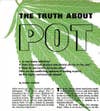
Although LSD was the 1960’s most controversial drug, marijuana was the substance du jour. Easier to obtain and less trippy than LSD, marijuana was pushed to the forefront of a nationwide legality debate that continues even today. Although people had smoked pot for hundreds of years, its renewed popularity invited questions about its addictiveness, its propensity for increasing crime rate, and of its mental effects. We appointed none other than Robert Gannon, who was still reeling from success of his explosive LSD article, to give our readers a primer on marijuana.
Gannon recalled, as we did 30 years prior, that all legal consequences aside, growing “grass” is as simple as scattering a few seeds in one’s front yard. Although 95 percent of marijuana came from Mexico, a few ambitious reapers quietly farmed their own cannabis on American farmland. One 18 year-old was arrested after narcotics agents discovered his acre-sized pot farm in Virginia, which was valued at around $100,000.
After outlining the many physical effects of marijuana, which our readers at the time were likely already familiar with, Gannon concluded his article by arguing that marijuana is not addictive in the same sense that narcotics are. Firstly, users did not experience withdrawal, meaning that marijuana is not physically addictive. Secondly, experts said that pot isn’t actually a gateway drug for stronger narcotics. If anything, the same criminal underground that handled hard drugs would help distribute marijuana, since it was illegal, thus perpetuating the industry.